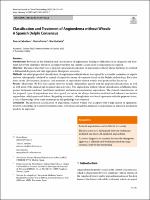| dc.contributor | Vall d'Hebron Barcelona Hospital Campus |
| dc.contributor.author | Guilarte Clavero, Mar |
| dc.contributor.author | Ferrer, Marta |
| dc.contributor.author | Caballero, Teresa |
| dc.date.accessioned | 2023-02-21T11:08:32Z |
| dc.date.available | 2023-02-21T11:08:32Z |
| dc.date.issued | 2023-01 |
| dc.identifier.citation | Caballero T, Ferrer M, Guilarte M. Classification and Treatment of Angioedema without Wheals: A Spanish Delphi Consensus. Am J Clin Dermatol. 2023 Jan;24:135–41. |
| dc.identifier.issn | 1179-1888 |
| dc.identifier.uri | https://hdl.handle.net/11351/9024 |
| dc.description | Angioedema; Delphi Consensus |
| dc.description.abstract | Introduction
Problems in the definition and classification of angioedema, leading to difficulties in its diagnosis and treatment, have been identified; therefore, an improvement in the current classification of angioedema is required.
Objective
The aim of this study was to propose a practical classification of angioedema without wheals that helps to establish a differential diagnosis and take appropriate therapeutic decisions.
Methods
An initial proposal of classification of angioedema without wheals was agreed by a scientific committee of experts and was subsequently validated by a panel of experts by means of consensus based on the Delphi methodology. Forty-five items on the classification, diagnosis, and treatment of angioedema without wheals were proposed for the survey.
Results
Most items (93.8%) were agreed after two rounds. All panelists agreed with the proposed classification, as well as with most of the clinical and treatment characteristics. The angioedema without wheals classification established three groups: histamine-mediated, bradykinin-mediated, and unknown mechanism angioedema. The clinical characteristics of the proposed types of angioedema were also agreed, except for the allergic histamine-mediated and unknown mechanism angioedema, which generated debate. Regarding treatments, although there was broad agreement with the proposed items, a lack of knowledge about some treatments in this pathology was observed.
Conclusion
The proposed classification of angioedema without wheals was accepted with a high degree of agreement; however, knowledge of available treatments needs to be increased and the definition of angioedema of unknown mechanism needs to be improved. |
| dc.language.iso | eng |
| dc.publisher | Springer |
| dc.relation.ispartofseries | American Journal of Clinical Dermatology;24 |
| dc.rights | Attribution-NonCommercial 4.0 International |
| dc.rights.uri | http://creativecommons.org/licenses/by-nc/4.0/ |
| dc.source | Scientia |
| dc.subject | Dermatitis - Diagnòstic |
| dc.subject | Presa de decisions |
| dc.subject | Al·lèrgia |
| dc.subject.mesh | Consensus |
| dc.subject.mesh | Angioedema |
| dc.subject.mesh | /diagnosis |
| dc.title | Classification and Treatment of Angioedema without Wheals: A Spanish Delphi Consensus |
| dc.type | info:eu-repo/semantics/article |
| dc.identifier.doi | 10.1007/s40257-022-00735-7 |
| dc.subject.decs | consenso |
| dc.subject.decs | angioedema |
| dc.subject.decs | /diagnóstico |
| dc.relation.publishversion | https://doi.org/10.1007/s40257-022-00735-7 |
| dc.type.version | info:eu-repo/semantics/publishedVersion |
| dc.audience | Professionals |
| dc.contributor.organismes | Institut Català de la Salut |
| dc.contributor.authoraffiliation | [Caballero T] Servicio de Alergia, Hospital Universitario la Paz, IdiPAZ, Madrid, Spain. [Ferrer M] Departamento de Alergología e Inmunología Clínica, Clínica Universidad de Navarra, Instituto de Investigación Sanitaria de Navarra (IDISNA), Pamplona, Navarra, Spain. [Guilarte M] Servei d’Al·lergologia, Servei de Medicina Interna, Vall d’Hebron Hospital Universitari, Barcelona, Spain. Vall d’Hebron Institut de Recerca (VHIR), Barcelona, Spain |
| dc.identifier.pmid | 36310330 |
| dc.identifier.wos | 000876234300001 |
| dc.rights.accessrights | info:eu-repo/semantics/openAccess |

